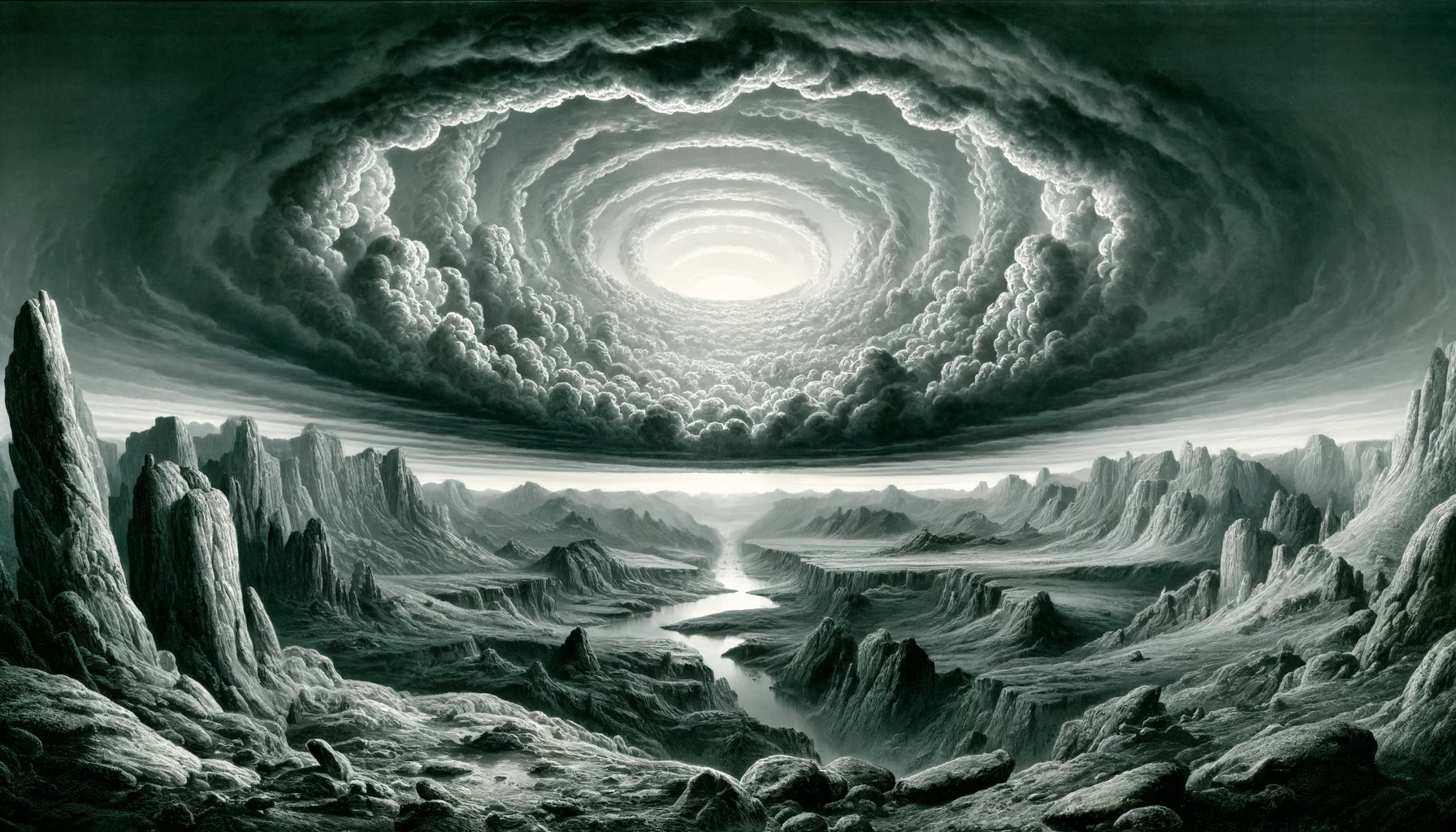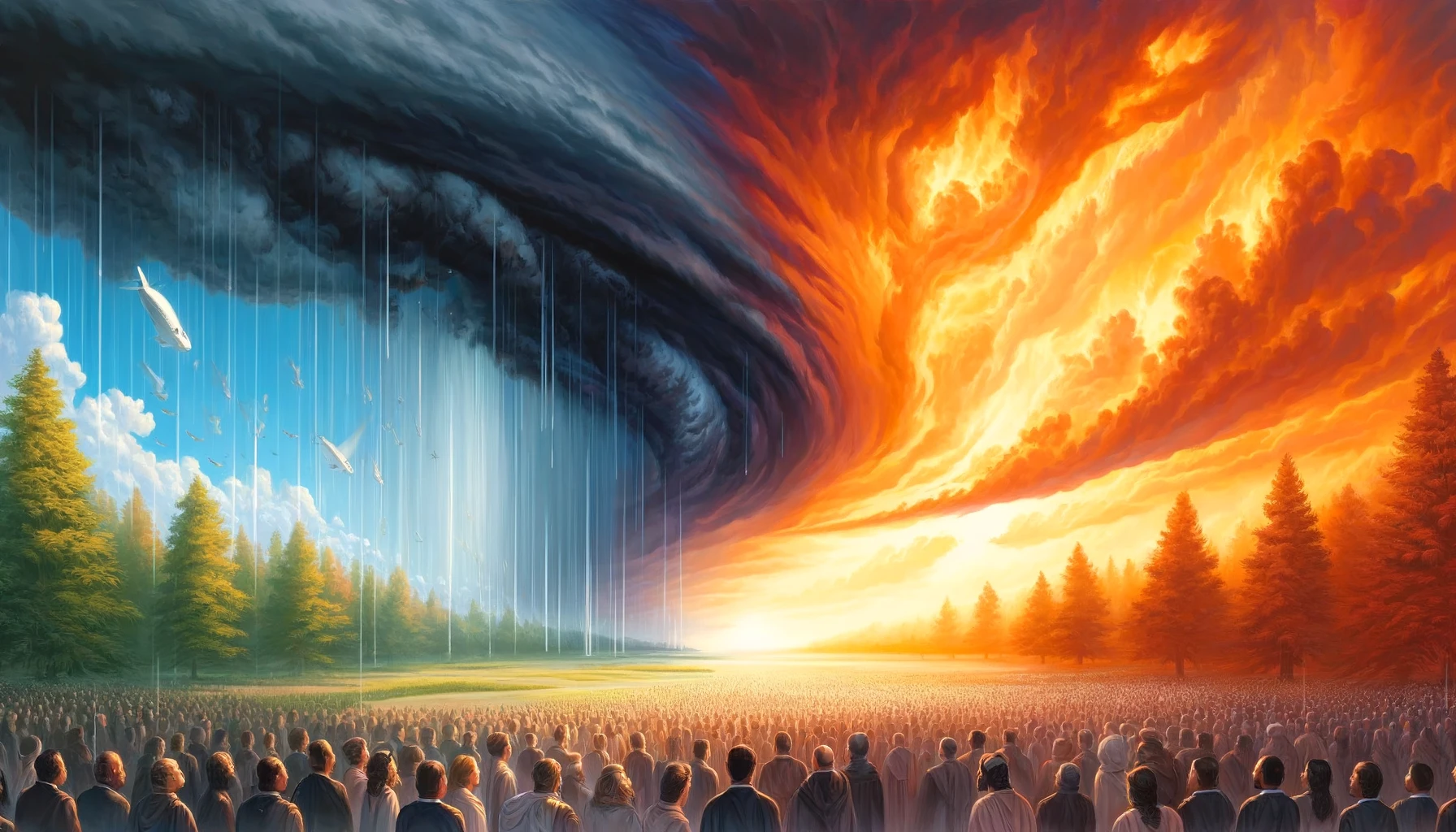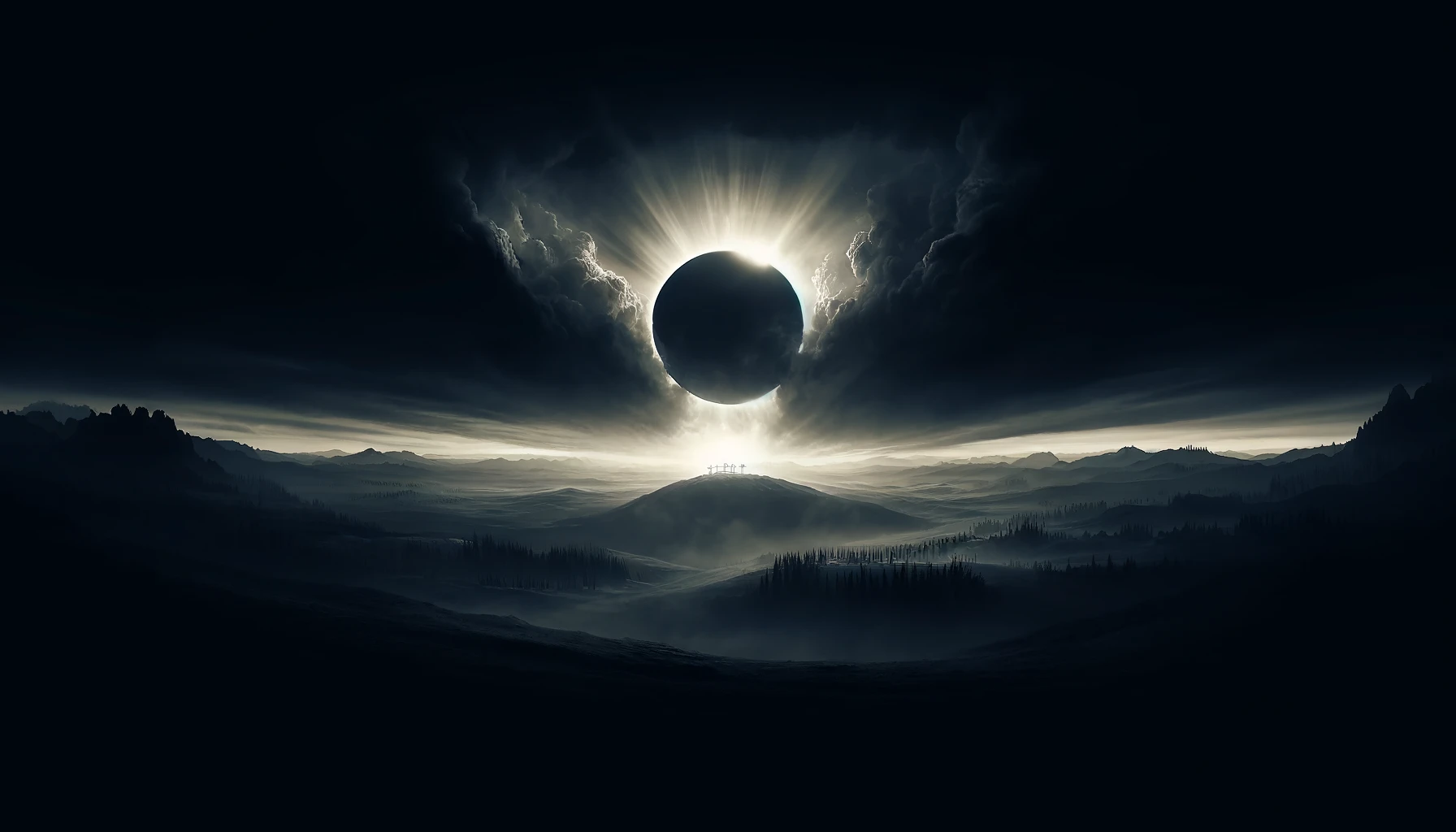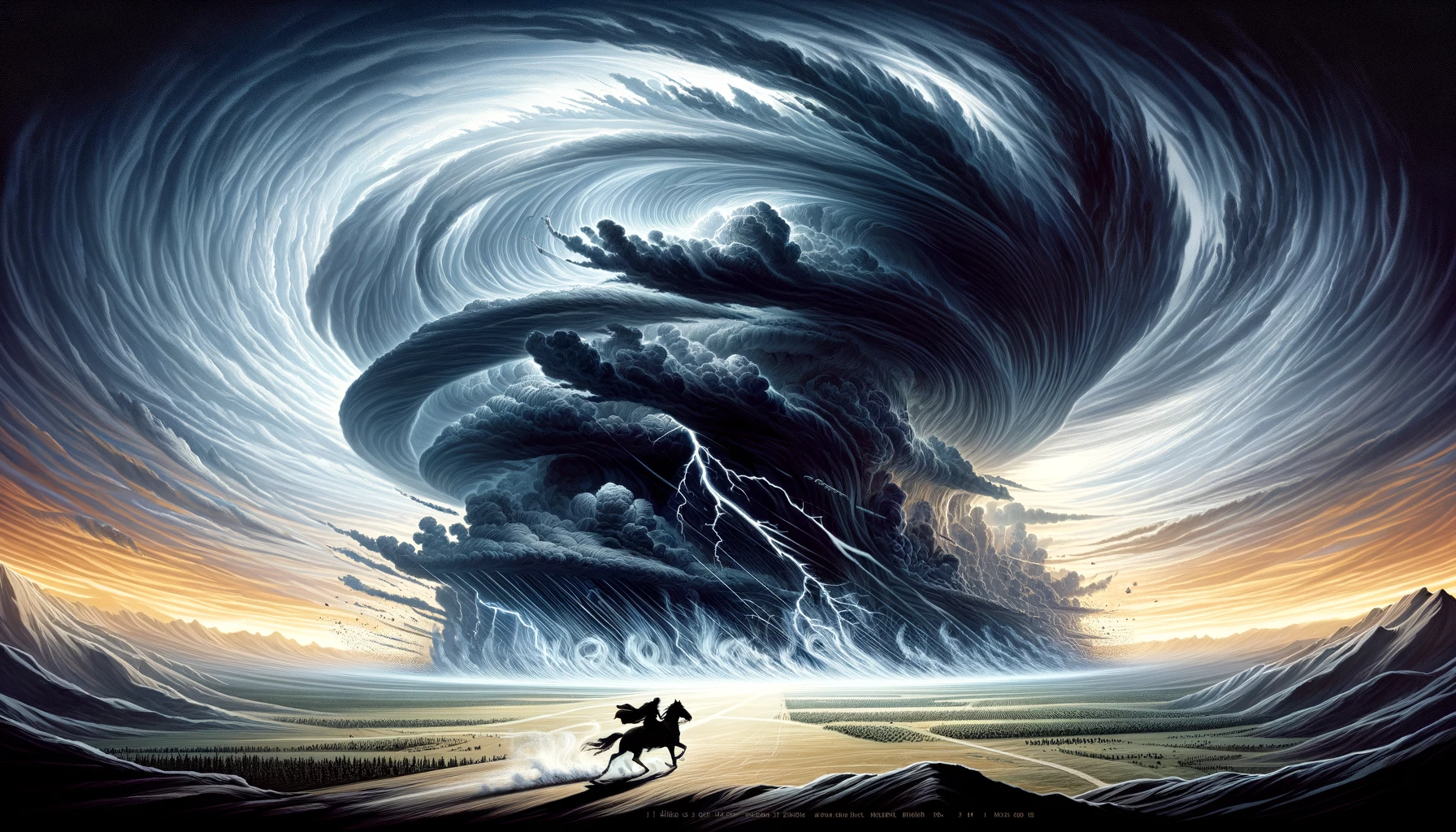Estimated reading time: 12 minutes

The sky, a vast and majestic expanse that stretches above us, has been a source of wonder and inspiration throughout human history. In the sacred texts of the Bible, the sky is not just a physical entity but a symbol of God’s omnipotence and glory.
Bible verses about the sky span from Genesis’s detailed account of its creation to Revelation’s awe-inspiring visions of the apocalypse, each providing a unique perspective on this magnificent creation. These scriptures illustrate the sky as a canvas for the divine, where God manifests His power, communicates His promises, and displays His eternal glory.
The sky is a constant reminder of God’s sovereignty over the natural world and His unending faithfulness to His creation. By exploring these 23 verses, believers and readers can gain insights into the sky’s significance in biblical doctrine, reflecting on themes such as divine majesty, prophetic signs, and the splendor of God’s creation.
Genesis 1:8
“And God called the expanse Heaven. And there was evening and there was morning, the second day.” -Genesis 1:8 (NRSV)
Reflection: When God named the expanse ‘Heaven,’ He was essentially setting apart the entire celestial realm, a divine act foundational to the creation narrative. This moment represents the emergence of the “new heavens,” a concept that extends beyond the physical sky to symbolize the expansive rule and sovereignty of the “Lord God” over all creation. The naming itself, an act of divine authority, highlights God’s throne established within the “heaven of heavens,” where He reigns supreme over both the visible and the invisible.
Psalm 19:1
“The heavens declare the glory of God; the skies proclaim the work of his hands.” -Psalm 19:1 (NRSV)
Reflection: In this verse, the heavens are depicted as not merely a physical space but as a dynamic canvas displaying the “work of your fingers.” The skies, in their vast expanse, declare the glory of the “Lord God,” acting as heralds of His divine artistry and power. The celestial phenomena, from the “stars of the sky” to the meteorological marvels, are daily testimonies of God’s ongoing creative acts and eternal power.

Isaiah 55:10
“For as the rain and the snow come down from heaven, and do not return there until they have watered the earth, making it bring forth and sprout, giving seed to the sower and bread to the eater.” -Isaiah 55:10 (NRSV)
Reflection: Isaiah beautifully parallels the nourishing function of the sky with the spiritual nourishment provided by God’s word. The rain and snow from the heavens embody God’s promises materializing on Earth, essential for growth and sustenance. This metaphor extends to the “word of God,” which, like the hydrological cycles, does not return void but accomplishes great things, ensuring the flourishing of His “kingdom on earth” as in heaven.
Matthew 16:2-3
“He answered them, ‘When it is evening, you say, ‘It will be fair weather, for the sky is red.’ And in the morning, ‘It will be stormy today, for the sky is red and threatening.’ You know how to interpret the appearance of the sky, but you cannot interpret the signs of the times.'” -Matthew 16:2-3 (NRSV)
Reflection: Here, Jesus critiques the reading of the skies for weather predictions while missing the “signs of the times” linked to the “Kingdom of Heaven.” This calls for discernment in recognizing the greater signs from God—those signaling spiritual shifts and the “tribulation of those days,” echoing the need for spiritual, not just meteorological, insight.
Acts 1:11
“Men of Galilee, why do you stand looking up toward heaven? This Jesus, who has been taken up from you into heaven, will come in the same way as you saw him go into heaven.” -Acts 1:11 (NRSV)
Reflection: This verse emphasizes Jesus’s ascension as a literal and figurative uplifting into the skies, directly into the “throne of God.” It also promises His return in the same spectacular fashion, reinforcing the sky’s role as the realm where divine promises are visualized and realized, connected with the “last days” and the eternal kingdom of God.
Revelation 6:13-14
“And the stars of heaven fell to the earth as the fig tree drops its winter fruit when shaken by a gale; the sky vanished like a scroll rolling itself up, and every mountain and island was moved from its place.” -Revelation 6:13-14 (NRSV)
Reflection: The dramatic imagery of the heavens rolling up and stars falling underscores the cataclysmic changes during the end times described in Revelation. This depicts not only physical disruptions but also symbolizes the shaking of the “powers of the heavens,” as the old order represented by the current heavens and earth gives way to the “new heavens and a new earth.”

Job 37:18
“Can you, like him, spread out the skies, hard as a cast metal mirror?” -Job 37:18 (NRSV)
Reflection: Job’s reflection on the sky, described as a “cast metal mirror,” speaks to its awe-inspiring creation, reflective of the “mighty works” of God. This metaphor underscores the sky’s role as a barrier or firmament, crafted by the “work of your fingers,” showcasing the divine craftsmanship and the unsearchable wisdom of God.
Isaiah 50:3
“I clothe the heavens with blackness, and I make sackcloth their covering.” -Isaiah 50:3 (NRSV)
Reflection: The imagery of cloaking the heavens in blackness evokes God’s sovereign control over the “expanse of the heavens.” This act of divine envelopment in darkness can be seen as a precursor to the “great and terrible day of the Lord,” when the sky acts as a canvas for displaying God’s judgment and might.
Jeremiah 4:25
“I looked, and there was no man, and all the birds of the heavens had fled.” -Jeremiah 4:25 (NRSV)
Reflection: The land’s desolation under a silent sky is a potent symbol of divine wrath and the cessation of normal divine blessings like rain, often considered the “floodgates of the sky.” This image reflects the severity of God’s judgment, where even the birds of the air flee, leaving the heavens bare as a sign of the impending “great tribulation.”
Genesis 1:14-15
“And God said, ‘Let there be lights in the dome of the sky to separate the day from the night; and let them be for signs and for seasons, and for days and years.'” -Genesis 1:14-15 (NRSV)
Reflection: The creation of celestial bodies as markers for times and seasons underscores the sky’s role as a divine clockwork governed by the “word of the Lord.” This purposeful placement of lights in the sky highlights the orderly nature of God’s creation, ensuring the regulation of life on Earth according to divine timing, reflecting the “signs of the heavens” for human governance.
Daniel 12:3
“Those who are wise will shine like the brightness of the sky, and those who lead many to righteousness, like the stars forever and ever.” -Daniel 12:3 (NRSV)
Reflection: The wise shining like the brightness of the heavens symbolizes the ultimate reward for righteousness, likening the redeemed to the “stars of the heavens” in their luminous and enduring quality. This vision offers a glimpse into the glorious future prepared for those who lead many to righteousness, underpinning the heavenly reward with celestial imagery.

Ezekiel 1:28
“Like the appearance of the bow that is in the cloud on the day of rain, so was the appearance of the brightness all around. This was the appearance of the likeness of the glory of the Lord.” -Ezekiel 1:28 (NRSV)
Reflection: The rainbow’s appearance in the clouds around the divine figure in Ezekiel’s vision reinforces the covenantal sign and the splendor of the “throne of God,” depicted through natural phenomena. The rainbow, set against the sky, acts as a bridge between God and humanity, symbolizing peace and the enduring promise of divine presence.
Matthew 24:30
“Then the sign of the Son of Man will appear in heaven, and then all the tribes of the earth will mourn, and they will see the Son of Man coming on the clouds of heaven with power and great glory.” -Matthew 24:30 (NRSV)
Reflection: As the “sign of the Son of Man” appears in the sky, it heralds the climactic return of Christ, with the sky as the stage for this divine epiphany. This apocalyptic sign, set against the “powers of the heavens,” marks a pivotal moment in eschatological prophecy, signaling the restoration of all things and the inauguration of the “new earth.
Revelation 1:7
“Look! He is coming with the clouds; every eye will see him, even those who pierced him; and on his account all the tribes of the earth will wail.” -Revelation 1:7 (NRSV)
Reflection: The vision of Christ coming with the clouds emphasizes the sky’s role as a divine portal, through which the “loud voice” of the archangel and the “trump of God” will proclaim the final advent. The imagery of every eye seeing Him, even those who pierced Him, ties back to the prophetic visions of the “great sign” seen across the whole of heaven, fulfilling the prophetic declarations of the “last days.”
Luke 21:27
“Then they will see the Son of Man coming in a cloud with power and great glory.” -Luke 21:27 (NRSV)
Reflection: Luke emphasizes the awe-inspiring vision of the Son of Man coming in a cloud, with power and great glory, seen across the “whole heaven.” This celestial event symbolizes the ultimate fulfillment of God’s promises, the final ushering in of the “kingdom of God,” where Christ’s sovereignty is made manifest and visible to all nations.

Luke 12:54-56
“He also said to the crowds, ‘When you see a cloud rising in the west, you immediately say, ‘It is going to rain’; and so it happens. And when you see the south wind blowing, you say, ‘There will be scorching heat’; and it happens. You hypocrites! You know how to interpret the appearance of the earth and the sky, but you do not know how to interpret the present time.'” -Luke 12:54-56 (NRSV)
Reflection: This passage illustrates the common understanding of weather patterns and the sky’s appearance in predicting them, juxtaposed with the failure to comprehend the eschatological signs that are equally evident. Jesus’ rebuke encourages a broader, deeper understanding of the divine dynamics at play, reflective of the “spirit of God” that moves through history, guiding and warning through signs in the skies.
Genesis 1:3
“Then God said, ‘Let there be light’; and there was light.” -Genesis 1:3 (NRSV)
Reflection: The command “Let there be light” marks the first divine utterance that shapes the cosmos, with the sky subsequently playing a critical role in separating the light from darkness. This foundational act of creation reflects the “word of God” as a creative force, establishing the elemental structures of the universe, including the “expanse of the heavens,” which governs these primal elements.
Joel 2:30
“I will show portents in the heavens and on the earth, blood and fire and columns of smoke.” -Joel 2:30
Reflection: The prophetic declaration of wonders in the heavens—blood, fire, and smoke—serves as a prelude to the “great and dreadful day of the Lord.” The sky becomes a prophetic canvas, displaying the “mighty works” of God as signs of impending judgment and the call to repentance, echoing the transformative power of the “last days.”

Matthew 27:45
“From noon until three in the afternoon darkness came over all the land.” -Matthew 27:45 (NRSV)
Reflection: The supernatural darkness that enveloped the land during the crucifixion of Jesus as described in Matthew symbolizes the spiritual significance of this event. This darkness, a manipulation of the “floodgates of the sky,” serves as a divine sign marking the moment of the world’s redemption, reflecting the “breath of his mouth” in a physical manifestation of grief and judgment.
Mark 13:24-25
“But in those days, after that suffering, the sun will be darkened, and the moon will not give its light, and the stars will be falling from heaven, and the powers in the heavens will be shaken.” -Mark 13:24-25 (NRSV)
Reflection: The cosmic disturbances described—darkening sun, unlit moon, falling stars—symbolize the ultimate upheaval of the created order in preparation for the new creation. These signs in the heavens reflect the dramatic reordering of the cosmos, involving the “powers of the heavens” being shaken, heralding the advent of the “new earth” under Christ’s righteous reign.
2 Samuel 22:12
“He made darkness canopies around him, a mass of waters, thick clouds of the sky.” -2 Samuel 22:12 (NRSV)
Reflection: David’s poetic description of God shrouding Himself in darkness, with dense clouds of the sky, uses meteorological imagery to symbolize divine mystery and majesty. This depiction enhances the portrayal of God as an enigmatic sovereign, whose ways and judgments, hidden behind the “doors of heaven,” are beyond human comprehension, yet always just and righteous.
Isaiah 34:4
“All the host of heaven shall rot away, and the skies roll up like a scroll. All their host shall fall, as leaves fall from the vine, like leaves falling from the fig tree.” -Isaiah 34:4 (NRSV)
Reflection: The prophecy of the heavens being rolled up like a scroll captures the dramatic end of the cosmic status quo, signaling the establishment of the “new heavens.” This apocalyptic imagery signifies the transient nature of the current creation in contrast to the eternal and unchanging nature of God, underscoring the radical transformation involved in the establishment of the “new heavens and new earth.”

1 Kings 18:45
“In a little while the sky grew black with clouds and wind, and there was a heavy shower. And Ahab rode and went to Jezreel.” -1 Kings 18:45
Reflection: The rapid gathering of clouds and the subsequent rainfall symbolize divine responsiveness to Elijah’s prayers, illustrating the sky’s role as a medium for God’s interaction with His prophets. This event not only displays the “mighty works” of God but also His control over the “waters of the sea” and the “floodgates of the sky,” affirming His lordship over all creation and His readiness to respond to the faithfulness of His servants.

The exploration of these 23 Bible verses reveals the sky as a dynamic and multifaceted symbol in the biblical narrative, rich with theological significance. From its role in marking the sacred rhythms of time to its function as a backdrop for divine revelations, the sky is portrayed as an active participant in God’s ongoing interaction with humanity. It stands as a testament to the Creator’s power, a bearer of prophetic messages, and a witness to the unfolding of God’s grand narrative from creation through to the eschaton.
This celestial expanse prompts us to contemplate God’s sovereignty over all creation. As we reflect on these scriptures, let us be inspired by the sky’s enduring beauty and its role as a divine canvas, painting a picture of hope, promise, and transformation. In the vastness of the sky, we find a mirror reflecting God’s glory, a call to worship in awe of the “host of heaven” and a reminder of the eternal life promised through faith.
Engaging with these verses encourages a deeper appreciation for the profound connections between the created world and spiritual truths, urging us to live in awareness of God’s omnipresence and to anticipate the glorious return of the Lord Jesus Christ, as foretold by the prophets and apostles against the backdrop of the heavens.
FAQ: Bible Verses About the Sky and Its Spiritual Significance
The sky is often used in Scripture as a symbol of God’s glory, power, and divine activity. It represents both the physical heavens and spiritual realms, serving as a canvas for God’s signs, promises, and presence.
Biblically, the sky symbolizes God’s majesty, the dwelling place of the divine, prophetic revelation, judgment, and hope. It’s also where key eschatological events are depicted to unfold.
Verses like Isaiah 55:10 and Ezekiel 1:28 show how rain and the rainbow are both literal and metaphorical signs of God’s faithfulness and covenant with humanity.
Absolutely. Books like Revelation, Matthew, and Joel describe dramatic cosmic events in the sky, such as stars falling, darkness, and the appearance of the Son of Man.
Jesus is described as ascending to and returning from the sky (Acts 1:11, Revelation 1:7). His second coming is associated with clouds and heavenly signs, emphasizing His divine authority.
Because it often displays God’s power and intentions—through rain, stars, clouds, and supernatural events—revealing His communication and interaction with humanity.
For Further Study
- Dwell– An App to help you listen to, read along with, memorize, and study your favorite Bible versions.
- Expanse of Heaven: Where Creation & Astronomy Intersect by Danny R. Faulkner- This book systematically explains what we know about the heaven above our heads by using our God-given urge to investigate. You will be enthralled as you explore the wonders of God’s creation and grapple with understanding the technicalities through the lens of Scripture.
- Logos– Gain more insights during your Bible study with Logos Bible software.
The aforementioned partner products are affiliate links, which means that we may receive a commission if you purchase through our links, but this comes at no additional cost to you.
